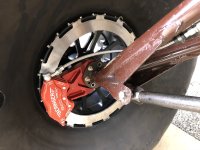BC12D-4-85
SPONSOR
Fairbanks, AK.
Shovels...ahh getting old when experience tells us to drill some holes in them so water can drain away when shoveling wet overflow on lakes from under stuck planes on skis. Had a C-185 on AWB 3600's submarine one ski under a foot of snow and a layer of ice above a foot of water and the main lake ice cover. Chopped and dug a trench until I could drive it up on the lake's shore and turn it around. Shovel had holes and an axe was handy. The two idiots onboard had forgot the snowshoes in the truck but bunny boots full of water saved the day.
Gary
Edit: We shoveled the wet snow away and cut trench in the thin upper ice layer as noted as the left ski and tail ski were stuck in it. Then moved the plane slowly in steps until near the shore it got thinner water. We filled the trench with snow and drove the plane back up on top to the shore. Shoveled bare spots on the dry shore, dropped the wheels, and turned the plane. Pumped the skis down and left for coffee and pizza. I had drug the lake three times hard before landing (three wide tracks next to each other) but no overflow showed until we slowed down.
Gary
Edit: We shoveled the wet snow away and cut trench in the thin upper ice layer as noted as the left ski and tail ski were stuck in it. Then moved the plane slowly in steps until near the shore it got thinner water. We filled the trench with snow and drove the plane back up on top to the shore. Shoveled bare spots on the dry shore, dropped the wheels, and turned the plane. Pumped the skis down and left for coffee and pizza. I had drug the lake three times hard before landing (three wide tracks next to each other) but no overflow showed until we slowed down.
Last edited:














